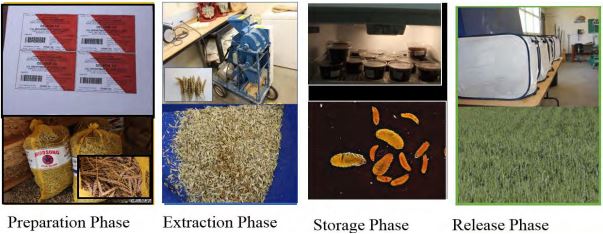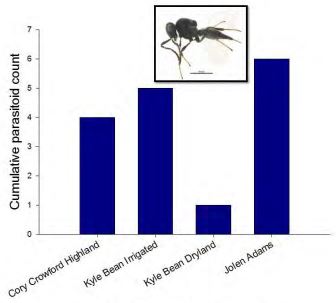Introduction and establishment assessment of two biocontrol agents Euxestonotus error and Platygaster tuberosula for wheat midge management
Principal Investigator: Gadi V.P. Reddy
Project Personnel: Govinda Shrestha
Western Triangle Agricultural Research Center,
Montana State University,
9546 Old Shelby Rd.,
P.O. Box 656,
Conrad, MT 59425, USA
Aim of the Study
The aim of the study were: 1) to release the parasitoids Euxestonotus error and Platygaster tuberosula for the control of wheat midges in western Montana and 2) to assess the establishment of E. error and P. tuberosula in 2016 release site (Valier) of Montana.
Material and Methods
-
Releasing the parasitoids Euxestonotus error and Platygaster tuberosula for the control of wheat midges in western Montana
The 2017 parasitoids releasing methods were similar to the 2016 study. The following four series of steps used for rearing and releasing of parasitoids: 1) collection and storage of parasitoids, 2) taking out parasitoids from refrigerators, 3) selection of wheat midge infested spring wheat fields, and 4) releasing the parasitoids (Fig 1).
Collection and storage of parasitoids
Prior to parasitoids collection, the federal import permits (Permit#P526-141217-033) for E. error and P. tuberosula were issued on July, 2016 by USDA-Animal and Plant Health Inspection Service. In August 2016, approximately 20,000 wheat heads were collected from spring wheat fields of Langenburg, Saskatchewan (Canada) where both parasitoids had been released in early 1990s and reported to be established. Immediately after the collection of heads, they were transported to Western Triangle Agriculture Research Center (WTARC), Montana State University, and the wheat heads were spread out in an even layer and left at room temperature (19–22°C) to dry for approximately two weeks in the laboratory. A small-sample de-awning machine was used to gently threshed dried heads. Midge larvae containing parasitoids were separated from the seeds and the chaff with an air cleaner. Approximately 1500 larvae were harvested in this manner from 20,000 infested wheat heads. Harvested larvae were then placed in a soil-less mixture of vermiculite and sphagnum and stored at 2–4°C.
Taking out parasitoids from the refrigerator
The soil mixtures containing the parasitoid larvae were taken out from the insect refrigerator on May 30, 2017. The parasitoids larvae were placed in plastic round deli container. However, the container was first filled with garden soil and afterwards the larvae were placed in top layer of the soil. These containers were sprayed (hand sprayer) with distilled water (3-4 ml) to moisten the soil. When the parasitoids were expected to emerge (3 weeks after the incubation), all these containers were taken out from the growth chamber and placed in insect cages where they were further sprayed with distilled water at 1-2 days intervals. In each insect cage, about 5-7 plastic containers were placed and the parasitoids emergence were observed every day. The emerged parasitoids were observed under a microscope to determine the species.
Fig 1. Whole release process of parasitoids
Grower Name
Crop Type
GPS Coordinates
Approx. Distances from 2016 Parasitoid released
sites
Cory Crawford, Crestview
Road
Irrigated
Lat:48.30206, Lng: -112.1435
2 miles
Cory Crawford, Belgian
Hill Road
Irrigated
Lat: 48.30647, Lng: -112.15275
10 miles
Cory Crawford, High land
Road
Irrigated
Lat: 48.317322, Lng:-112.227895
Released site
Jodi Hobel, Belgian Hill
Road
Irrigated
Lat: 48.2861, Lng: -112.0552
10 miles
Jodi Hobel, Crestview
Road
Dryland
Lat: 48.30131, Lng: -112.1201
2.2 mils
Jolena Adams, North Valier
Irrigated
Lat: 48.35183, Lng: -112.21256
0.01 miles
Kyle Bean, North Valier
Irrigated
Lat: 48.4317, Lng: -112.1848
2 miles
Kyle Bean, North Valier
Dryland
Lat: 48.38166, Lng: -112.25097
1 mile
Table 1. Parasitoid sampled field sites, Valier, MT, 2017
Selection of wheat midge infested fields for release of parasitoids
Two wheat midge infested spring wheat fields were selected at around third week of June, 2017 in Ledger and Teton, Montana, based on midges trap count data. The consideration of these locations were mainly because the parasitoids were released in Valier 2016. Immediately after the fields selection, sweep netting activity (1-2 times before the parasitoids release) was performed in order to know either there was a presence of parasitoids or not before to releases.
-
Assessing the establishment of Euxestonotus error and Platygaster tuberosula in Valier, Montana.
Eight spring wheat fields were sampled to check the presence of P. tuberosula and E. error in Valier MT (Table 1). Sweep net sampling was began from last week of June and continued until the end of growing season. About 120 sweeps were made per field and the collected samples were stored at -20O C until processing. The parasitoids were identified under a microscope.
Results
Status of parasitoids before to release
The detailed information about the pre-release was mentioned below (Table 2). No E. error and
P. tuberosula were found on the selected sites at parasitoids release.
Table 1. The information regarding to pre-releases of parasitoids
|
Pre-release sampling date |
Growers name |
Location |
GIS |
#Sweeps per field |
Status of parasitoids |
|
June 29, 2017 |
Terry Petes |
Ledger, MT |
48.24878; -111.6969 |
120 |
Not found |
|
June 29 , 2017 |
Terry Petes |
Teton, MT |
48.2509; -111.59902 |
120 |
Not found |
|
July 3, 2017 |
Terry Petes |
Teton MT |
48.2509; -111.59902 |
120 |
Not found |
Release of Euxestonotus error and Platygaster tuberosula
This year, WTARC team could not able to release the parasitoids in what midge infested spring wheat fields though the same 2016 parasitoid rearing procedure was used. Parasitoids emergence percentage was nearly zero, and only about 10 parasitoids were found to emergence in insect cages but at the end of crop harvest season.
Establishment of parasitoids
This study for the first time indicated the presence of P. tuberosula in nearby released fields of 2016. Among the eight field sampled sites, the P. tuberosula was found in four fields that were very adjacent to 2016 released sites (Fig 2). Two morphological characters were used for identification of this parasitoid: 1) antennal segments (10-12) and 2) bump in the thorax. This parasitoid species recorded in 5-20 July, 2017. It remained unclear for what could be the cause for not seeing the E. error in nearby released site, it was likely due to difference in preference stage of wheat midge.
Figure 2. Platygaster tuberosula parasitoid recorded field sites, Valier, 2017
Acknowledgements
We would like to thank summer intern Bert Paulsen for assistance with field work. This work was supported by Montana Wheat and Barley Committee.


